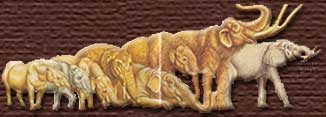|

The Evolution of The Elephant
At least 45
million years ago there lived a small tapir-like mammal named
Moeritherium.
The bones of this
creature were discovered near Lake Moeris in Egypt, where it got its name.
It had enlarged
incisors which were already developing into rudimentary tusks.. Most of
the ‘offshoots’ of this creature have died out but there are many fossil
remains that have been studied in great detail.
The only
evolutionary offshoot to witness the emergence of human beings was
*Elephantoidea.
Dwarf forms of
elephant and certain mammoths (which may have died out as dwarf species in
Siberia) became extinct.
After that time
there were only three species of Elephant to survive. The famous wooly
mammoth (Mammuthus primigenius), the Asian elephant (Elphas
maximus) and the African elephant (Loxodonta Africana).
Many elephants
before these times are known to have had four tusks but as the animals
began to grow and evolve they lost the tusks from the lower jaws as their
heads got bigger and their skulls spongier, they would have been unable to
support such weight. Their noses and upper lip lengthened into the trunks
we see today.
The Mammoth
Of
all the famous prehistoric animals the mammoth, it seems, is the most well
known.
The
mammoths looked much bigger than our elephants today but in fact it was
only about the size of one of our African elephants. It had a huge domed
head which made it look taller and its fur was at least 70 cms long,
giving it the appearance of an animal much larger . It’s tusks measured up
to five metres and were quite capable of spiralling into a complete
circle. They could have weighed up to 125 kilograms each.
It is
now believed that mammoths survived longer than was previously thought. It
was understood that the mammoths of Siberia and even Alaska died out ten
thousand years ago, now it seems possible according to Soviet
Investigators that it may have been as recent as 5 thousand years ago that
the last mammoth roamed the earth.
It is
not known exactly why this huge woolly beast did die out.
They
were hunted and in some cases driven over cliffs and this would have
contributed to part of their demise. Like elephants today, they had a long
breeding cycle and like today where elephants are poached or taken from
the wild to be trained and not bred, this would have led to orphans and
even more deaths.
The
climate was getting warmer too. It is believed the threat from hunting and
the receding ice caps would have driven the mammoth north but because the
coniferous forest belt was also edging that way the treeless tundra would
have been wedged between it and the Arctic Ocean.
The Survivors
The
Asian and African elephants were the only one to survive.
There
are two subspecies of the African elephant
Loxodonta africana africana is
the largest of the two. An adult bull African elephant can stand up to 3.5
metres tall; the biggest known was 4.1 metres tall. They can weigh between
4 and 10 tons. Its ears are very large, used to cool the elephant down and
to frighten any adversaries away. Both sexes of this genus have tusks.
These tusks grow curved, long and thick.
The
heaviest ever tusks to be found weighed 102.7 kilos. There are two
‘fingers’ at the end of their trunks which they use very dexterously to
manoeuvre very small and very large objects. The elephants rump rises
higher than it’s back and it’s head is very broad. The molars of the
African Elephant have lozenge shaped ridges, quite different from their
Asian Cousins.
Loxodonta africana cyclotis are
much more compact, being no more than 2.4 metres tall. They still weigh in
at 4 tons however. They have short tusks which grow downward or almost
straight out and they are think and heavy. Instead of having triangular
like ears like Loxodonta africana
africana theirs are more rounded.
The
Asian Elephant
(Elphas maximus)
is much smaller than
the African. It rarely grows taller than 3 metres and weighs about 3 tons,
although older domesticated elephants have been known to stand much taller
and weigh over 4 tons.
The
ears are quite small, not needing to be quite as big as the temperatures
do not get quite as high as in Africa. Only 60 per cent of male Asian
elephants carry tusks, which are usually short and light and the females
do not have them at all. Unlike it’s cousin the Asian elephant only has
one ‘finger’ on its lip at the tip of the trunk. It has an arched back and
a domed forehead. Their molars have rasping surfaces with parallel ridges.
Loxodonta africana cyclotis -
the African Forest Elephant
Shoulder height: up to 2.35 m
Typical features:
-
Flat forehead
-
Front legs noticeably longer than
hind legs
-
Four hooves on each front foot,
three on each hind foot
-
Small round ears
-
Two opposite fingers on the trunk
-
Females and males carry large
tusks.
-
Slate blue grey skin, coloured
pale brown by dirt and dust.
The lineage of the elephant

Left to right -
Moeritherium, Phiomia, Palaeomastodon, Gomphotherium, Deinotherium,
Mastadon, Mammuthus, Loxodonta.
The
body sizes in the above picture (The Life And Lore Of The Elephant -
New Horizons)
are
not accurate. The Mastadon was bigger than the Mammoth and the African
elephant.
*Order:
Proboscidea
Suborder: Moerithioidea*
Suborder: Deinotherioidea*
Suborder: Elephantoidea
Family: Gomphotheriidae*
Family: Mammutidae* (mastodonts)
Family: Elephantidae (elephants,
mammoths*)
* Extinct
Home
Organisations
Graphics
©2003
by Arco-Iris
Midi 'Big
Sky' by Keith Spillman |